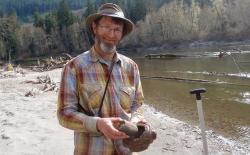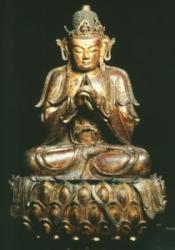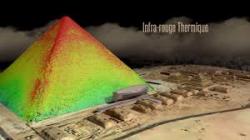INSTITUT SUPERIEUR D'ANTHROPOLOGIE
INSTITUTE OF ANTHROPOLOGY
ONLINE COURSES / COURS A DISTANCE
INSCRIPTION 2012 / Session III : Juillet 2012
REGISTRATION 2012 / Term III : July 2012
USA –  Cahokia Mounds - For the past few weeks, a group from the University of Bologna in Italy was excavating a site west of Monks Mound. "They're focusing on an enclosure first located in the 1960s," assistant site manager Bill Iseminger said. "It had bastions along it, a series of round and rectangular enclosures." As to what the structure's purpose might have been? For the ancient people who once built a great city that was the center of Mississippian culture for the entire metro-east and beyond, it could have been a marketplace, a house for visiting dignitaries or anything at all. "The bastions suggest a defensive feature to it," Iseminger said. The Italian team is not the only dig going on this summer at the mounds. Washington University will send a team to work on Mound 34, which is located several hundred feet east of the massive Monks Mound. Mound 34 once held a structure, but it is not yet known what it could have been. Iseminger said there was an old, amateur excavation in the 1950s, and Washington University has spent the past few summers reopening that excavation and using modern technology to find out more. "The area adjacent to (the mound) was a copper workshop; they can tell that from the remnants in the soil," Iseminger said. Even stains in the dirt can tell them details of the mysterious people who left only the mounds behind when they vanished, long before the settlers came, he said. "They can look at colors in the soil and see where roof supports and walls were, sometimes finding char from fires," Iseminger said. They know the Mississippians traveled and had connections far away, Iseminger said: They've found exotic materials like seashells, Oklahoman arrow points and shark's teeth not likely to be native to Illinois. But exactly what building stood atop Mound 34? They're still just guessing. "If it was on a mound, it could be a temple or other building of religious significance," Iseminger said. "The elite, more important people sometimes lived on the mound; priests or someone of high status." The in-house crew also will continue its examination of the palisade wall, a wooden fence constructed late in Cahokia's history that encircled the entire city and was rebuilt at least once. Its exact purpose is still unknown, Iseminger said.
Cahokia Mounds - For the past few weeks, a group from the University of Bologna in Italy was excavating a site west of Monks Mound. "They're focusing on an enclosure first located in the 1960s," assistant site manager Bill Iseminger said. "It had bastions along it, a series of round and rectangular enclosures." As to what the structure's purpose might have been? For the ancient people who once built a great city that was the center of Mississippian culture for the entire metro-east and beyond, it could have been a marketplace, a house for visiting dignitaries or anything at all. "The bastions suggest a defensive feature to it," Iseminger said. The Italian team is not the only dig going on this summer at the mounds. Washington University will send a team to work on Mound 34, which is located several hundred feet east of the massive Monks Mound. Mound 34 once held a structure, but it is not yet known what it could have been. Iseminger said there was an old, amateur excavation in the 1950s, and Washington University has spent the past few summers reopening that excavation and using modern technology to find out more. "The area adjacent to (the mound) was a copper workshop; they can tell that from the remnants in the soil," Iseminger said. Even stains in the dirt can tell them details of the mysterious people who left only the mounds behind when they vanished, long before the settlers came, he said. "They can look at colors in the soil and see where roof supports and walls were, sometimes finding char from fires," Iseminger said. They know the Mississippians traveled and had connections far away, Iseminger said: They've found exotic materials like seashells, Oklahoman arrow points and shark's teeth not likely to be native to Illinois. But exactly what building stood atop Mound 34? They're still just guessing. "If it was on a mound, it could be a temple or other building of religious significance," Iseminger said. "The elite, more important people sometimes lived on the mound; priests or someone of high status." The in-house crew also will continue its examination of the palisade wall, a wooden fence constructed late in Cahokia's history that encircled the entire city and was rebuilt at least once. Its exact purpose is still unknown, Iseminger said.
http://www.bnd.com/2012/06/03/2198472/digging-up-dirt-summer-excavations.html
USA –  Squamish River. - It was a routine academic mission for geoscientist Pierre Friele, but it ended with a discovery that goes back more than 1600 years. Friele stumbled upon a prehistoric bowl and two cobble pestles while guiding a student researcher who was studying sediments along the Squamish River. He found the bowl in a bank along the Squamish River, in an area opposite the creek mouth flowing from Lake Lovely Water. Carbon dating has determined the historical artefacts are more than 1,600 years old, said Rudy Reimer, a professor of First Nations history and archaeology at SFU. Friele said when he found the artifacts, he estimated them to be thousands of years old based on the amount of sediment deposited. "It doesn't happen in an instant. Every time there's a flood, there is a little bit of sediment deposited on it. There would have been a village in this location for thousands of years," he said. The discovery was a fluke. As Friele's student busied himself studying the river sediments, Friele wandered along river bank. He stopped when he noticed something peculiar at one particular spot about three metres from the top of the bank: the colour of the earth was red, a sign of burning. Seeing the red markings, Friele dug a little deeper and noticed the earth change to a black charcoal hue. Once he knew it was a fire hearth, Friele kept cleaning the face of the bank until he noticed a dark spot and a fragment of a stone. More cleaning revealed two pestles made of copper and then a bowl lying upside down in the hearth. The bowl has decorative carvings on it. "It's a mortar and a pestle, and it could have been used for crushing seeds and food, or for making paints and dyes," Friele said.
Squamish River. - It was a routine academic mission for geoscientist Pierre Friele, but it ended with a discovery that goes back more than 1600 years. Friele stumbled upon a prehistoric bowl and two cobble pestles while guiding a student researcher who was studying sediments along the Squamish River. He found the bowl in a bank along the Squamish River, in an area opposite the creek mouth flowing from Lake Lovely Water. Carbon dating has determined the historical artefacts are more than 1,600 years old, said Rudy Reimer, a professor of First Nations history and archaeology at SFU. Friele said when he found the artifacts, he estimated them to be thousands of years old based on the amount of sediment deposited. "It doesn't happen in an instant. Every time there's a flood, there is a little bit of sediment deposited on it. There would have been a village in this location for thousands of years," he said. The discovery was a fluke. As Friele's student busied himself studying the river sediments, Friele wandered along river bank. He stopped when he noticed something peculiar at one particular spot about three metres from the top of the bank: the colour of the earth was red, a sign of burning. Seeing the red markings, Friele dug a little deeper and noticed the earth change to a black charcoal hue. Once he knew it was a fire hearth, Friele kept cleaning the face of the bank until he noticed a dark spot and a fragment of a stone. More cleaning revealed two pestles made of copper and then a bowl lying upside down in the hearth. The bowl has decorative carvings on it. "It's a mortar and a pestle, and it could have been used for crushing seeds and food, or for making paints and dyes," Friele said.
http://www.piquenewsmagazine.com/whistler/squamish-artifact-dates-back-to-at-least-400-ad/Content?oid=2304405
CHINE –  Taklimakan Desert - Ruins of an ancient Buddhist temple have been found in the largest Chinese desert, Taklimakan Desert, dating back to 1,500 years ago. The new finding has brought greater research material to historians who study the spread of Buddhism from India to China. In the autonomous region of Xinjiang Uygur, now a mainly muslim area, the temples main hall along with a rare structure surrounded by three square-shaped corridors as well as evidence of a huge Buddha statue that existed years ago have been uncovered after 2 months of excavation. the leading archaeologist of the excavation project said, “The hall is the largest of its kind found in the Taklimakan Desert since the first archaeologist came to work in the area in the 20th century (usa.chinadaily.com).” The ruins were found and are located south of the Taklimakan Desert, in the Tarim Basin, known as the Damago Oasis. The ruins are located in the ancient kingdom of Khotan, which is a Buddhist civilization believed to date back to the third century BC. One key connection that has been made to India is that temple corridors in India were square-shaped like the ones found in the Buddhist site. They gradually disappeared after the Southern and Northern Dynasties (AD 420-581). To date, it is considered the best site to determine and research how the religion traveled from India to China. Based on the size of the pedestal, the missing Buddha statue is said to have been at least 3 meters tall. Altogether, the hall walls, surround an area of 256 square meters. Mural paintings of Buddha’s feet and some auspicious animals are still visible on the corridor walls. They are painted in a Greco-Buddhist artistic style. Since 1901, over 10 Buddhist sites have been discovered by archaeologists from China, and excavations throughout China are presently going on to discover more sites which can add to the history of Buddhism in the country.
Taklimakan Desert - Ruins of an ancient Buddhist temple have been found in the largest Chinese desert, Taklimakan Desert, dating back to 1,500 years ago. The new finding has brought greater research material to historians who study the spread of Buddhism from India to China. In the autonomous region of Xinjiang Uygur, now a mainly muslim area, the temples main hall along with a rare structure surrounded by three square-shaped corridors as well as evidence of a huge Buddha statue that existed years ago have been uncovered after 2 months of excavation. the leading archaeologist of the excavation project said, “The hall is the largest of its kind found in the Taklimakan Desert since the first archaeologist came to work in the area in the 20th century (usa.chinadaily.com).” The ruins were found and are located south of the Taklimakan Desert, in the Tarim Basin, known as the Damago Oasis. The ruins are located in the ancient kingdom of Khotan, which is a Buddhist civilization believed to date back to the third century BC. One key connection that has been made to India is that temple corridors in India were square-shaped like the ones found in the Buddhist site. They gradually disappeared after the Southern and Northern Dynasties (AD 420-581). To date, it is considered the best site to determine and research how the religion traveled from India to China. Based on the size of the pedestal, the missing Buddha statue is said to have been at least 3 meters tall. Altogether, the hall walls, surround an area of 256 square meters. Mural paintings of Buddha’s feet and some auspicious animals are still visible on the corridor walls. They are painted in a Greco-Buddhist artistic style. Since 1901, over 10 Buddhist sites have been discovered by archaeologists from China, and excavations throughout China are presently going on to discover more sites which can add to the history of Buddhism in the country.
http://www.chakranews.com/taklimakan-desert-in-china-reveals-an-ancient-buddhist-temple/2805
FRANCE –  Lyon - La reconversion de l'Hôtel-Dieu, site emblématique de la Presqu'île lyonnaise, est un moment fort d'évaluation patrimoniale et de mise en valeur d'un bâtiment prestigieux. Tout au long de ce vaste projet décliné en plusieurs étapes, l'archéologie préventive va accompagner Eiffage pour expertiser le potentiel archéologique des sous-sols de l'Hôtel-Dieu, fouiller les vestiges repérés et écrire l'histoire du site avant la construction du bâtiment imaginé par Soufflot au milieu du XVIIIe siècle. Un premier diagnostic a été réalisé en juillet 2011 par le service Archéologique de la Ville de Lyon dans l'une des principales cours de l'Hôtel-Dieu. Quelques décimètres sous le sol de l'actuelle cour de la Chaufferie, sont apparus les murs et dallages des maisons qui constituaient le bourg Chanin. Ce quartier, dont les premières mentions remontent au XIIIe siècle, s'était établi entre le bord du Rhône et l'actuelle rue Bellecordière à proximité du pont de la Guillotière. L'agrandissement de l'Hôtel-Dieu au XVIIIe siècle a fait disparaître les immeubles qui donnaient sur le fleuve, ceux qui subsistaient rue de la Barre et rue Bellecordière ont finalement disparu avec l'extension définitive de l'hôpital au XIXe siècle. Même si quelques immeubles anciens ont été conservés côté ouest de la rue Bellecordière, celle-ci a alors perdu son caractère médiéval. C'est à quatre mètres de profondeur que les niveaux les plus anciens ont pu être observés. Sur les limons déposés par le fleuve, des fondations de murs gallo-romains, très arasés, attestent la présence de la ville antique. Fondée sur la colline de Fourvière, la cité de Lugdunum s'est d'abord développée sur les hauteurs à l'abri des crues. Le confluent est ainsi resté longtemps un espace instable et soumis aux caprices des cours d'eaux et ce n'est qu'au Ier apr. J.-C. après d'importants travaux de viabilisation, que la ville a pu enfin s'étendre sur l'ensemble de la Presqu'île. Les éléments antiques découverts lors du diagnostic évoquent plutôt la ruine d'un quartier d'habitation dont le plan n'est pas encore lisible. Quelques fragments de fresque murale, révèlent un programme décoratif classique aux couleurs vives. Il faudra donc attendre les résultats de la fouille extensive de la cour pour qu'émerge avec plus de précisions l'organisation de ce quartier construit sur les rives du Rhône.
Lyon - La reconversion de l'Hôtel-Dieu, site emblématique de la Presqu'île lyonnaise, est un moment fort d'évaluation patrimoniale et de mise en valeur d'un bâtiment prestigieux. Tout au long de ce vaste projet décliné en plusieurs étapes, l'archéologie préventive va accompagner Eiffage pour expertiser le potentiel archéologique des sous-sols de l'Hôtel-Dieu, fouiller les vestiges repérés et écrire l'histoire du site avant la construction du bâtiment imaginé par Soufflot au milieu du XVIIIe siècle. Un premier diagnostic a été réalisé en juillet 2011 par le service Archéologique de la Ville de Lyon dans l'une des principales cours de l'Hôtel-Dieu. Quelques décimètres sous le sol de l'actuelle cour de la Chaufferie, sont apparus les murs et dallages des maisons qui constituaient le bourg Chanin. Ce quartier, dont les premières mentions remontent au XIIIe siècle, s'était établi entre le bord du Rhône et l'actuelle rue Bellecordière à proximité du pont de la Guillotière. L'agrandissement de l'Hôtel-Dieu au XVIIIe siècle a fait disparaître les immeubles qui donnaient sur le fleuve, ceux qui subsistaient rue de la Barre et rue Bellecordière ont finalement disparu avec l'extension définitive de l'hôpital au XIXe siècle. Même si quelques immeubles anciens ont été conservés côté ouest de la rue Bellecordière, celle-ci a alors perdu son caractère médiéval. C'est à quatre mètres de profondeur que les niveaux les plus anciens ont pu être observés. Sur les limons déposés par le fleuve, des fondations de murs gallo-romains, très arasés, attestent la présence de la ville antique. Fondée sur la colline de Fourvière, la cité de Lugdunum s'est d'abord développée sur les hauteurs à l'abri des crues. Le confluent est ainsi resté longtemps un espace instable et soumis aux caprices des cours d'eaux et ce n'est qu'au Ier apr. J.-C. après d'importants travaux de viabilisation, que la ville a pu enfin s'étendre sur l'ensemble de la Presqu'île. Les éléments antiques découverts lors du diagnostic évoquent plutôt la ruine d'un quartier d'habitation dont le plan n'est pas encore lisible. Quelques fragments de fresque murale, révèlent un programme décoratif classique aux couleurs vives. Il faudra donc attendre les résultats de la fouille extensive de la cour pour qu'émerge avec plus de précisions l'organisation de ce quartier construit sur les rives du Rhône.
http://www.lyon-communiques.com/communiques/que-revelent-les-premieres-fouilles-de-l-hotel-dieu-de-lyon-c83761.htm